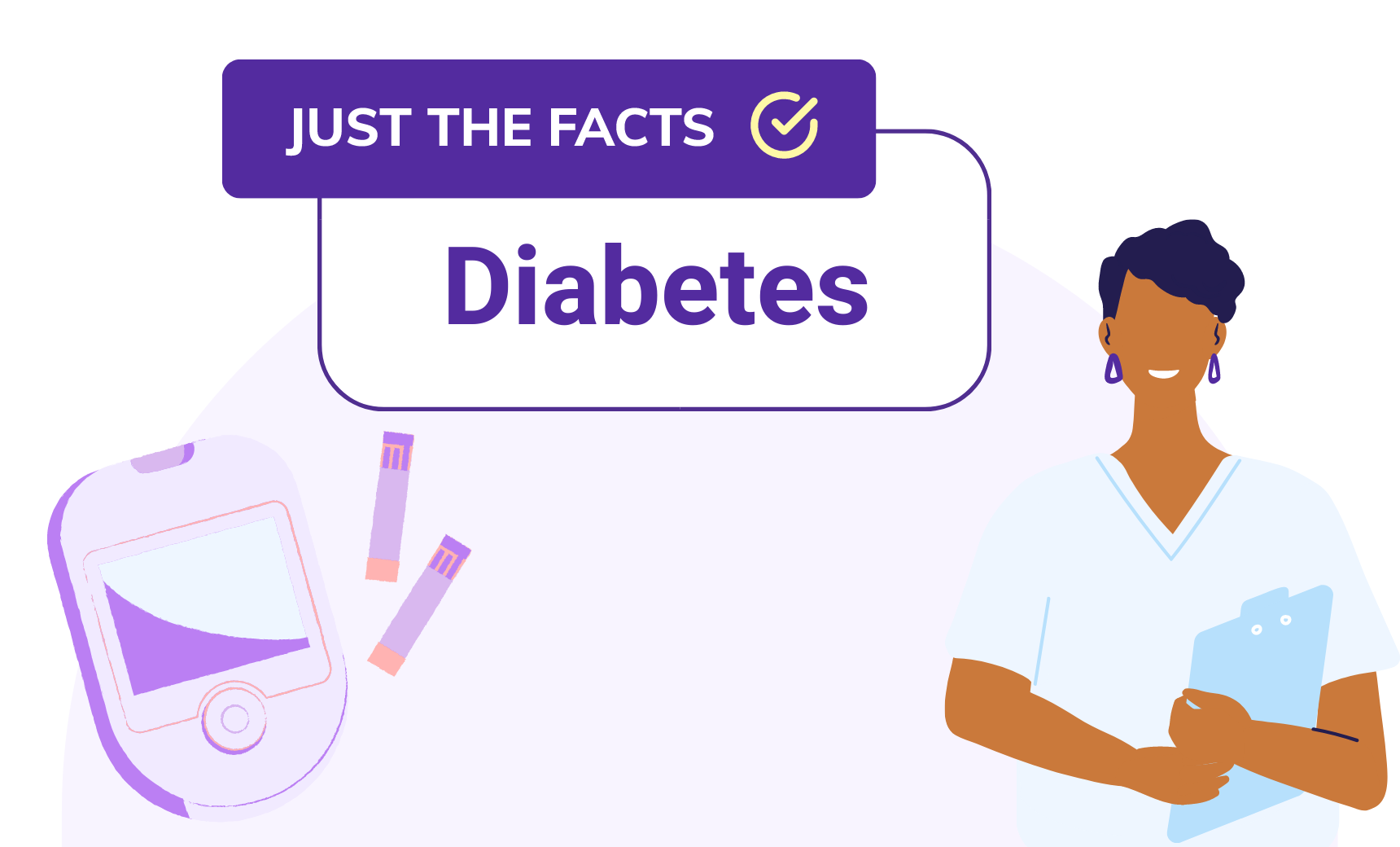
Just the Facts: Diabetes
What you need to know about diabetes, whether or not you’ve been diagnosed.
You have a strange tingling in your feet. You look in the mirror and realize that you’ve lost some weight without meaning to. Your skin feels dry, even when you moisturize, and you’re hustling to the bathroom to pee frequently. What’s going on? If you’ve ever been in this situation, your doctor may have suggested you get tested for diabetes.
You’ve likely heard about diabetes, one of the most prevalent diseases in America today, affecting approximately 10% of the population. But what exactly is diabetes? Knowledge is power and, because early detection is essential for long term health, knowing about diabetes can help you catch the chronic disease in yourself or others before it’s too late.
What is diabetes?
Diabetes Mellitus is a metabolic disorder in the way the body regulates sugar uptake. Glucose uptake into cells requires insulin, a hormone produced in the pancreas. Usually, after a meal, the pancreas releases insulin to regulate blood sugar. Those with diabetes don’t produce insulin or produce it less efficiently, which results in high blood glucose levels, or hyperglycemia. Carbohydrates—like bread, fruit, or candy—can be especially tricky for those with diabetes because carbs are broken down into sugar by the body.
High blood glucose levels can make you very sick, causing vomiting, hunger or thirst, and rapid heartbeat. In the long term, it can damage the kidneys, eyes, and nerves, leading to heart disease and stroke. Diabetes is known as “The Silent Killer” because of the nerve damage that can occur to small blood vessels, which gradually worsens if left untreated. This pathology can lead to silent heart attacks — nerves are damaged in the process and, without nerves, you can’t sense pain. If not managed properly, diabetes can also result in blindness and amputation.
What are the symptoms of diabetes?
- Increased thirst
- Increased hunger
- Fatigue or weight loss
- Increased urination
- Blurry vision
- Numbness in extremities
- Darkening of the skin on the neck, armpit, and groin
- Slow healing from wounds
- Frequent infections, such as yeast infections
What types of diabetes are there?
Type 1
Type 1 usually occurs in younger patients, caused by a lack of beta cells in the pancreas. Typical treatment includes routine insulin injections to replace what the body fails to make. Sometimes the condition can be auto-immune, where the body’s immune system attacks itself. This can be measured by determining if antibodies are present in the blood. Some of the antibodies seen in Type 1 diabetes include anti-islet cell antibodies, anti-insulin antibodies, and anti-glutamic decarboxylase antibodies.
Type 2
Type 2 typically occurs in adults. Unlike Type 1, in Type 2, the body doesn’t have a problem producing insulin but does have a problem at the receptor site. Glucose is unable to go inside the cells for energy when insulin binds itself to the receptor. Type 2 diabetes is often called insulin-resistant diabetes, non-insulin-dependent diabetes mellitus (NIDDM), or adult-onset diabetes mellitus (AODM).
How can I find out if I have diabetes?
A Hemoglobin A1C test can diagnose diabetes. This blood sugar test measures your blood sugar history over the previous 3 months. For those already diagnosed with diabetes, this test is regularly performed to help clinicians track the patient’s long-term diabetes status and see if patients are compliant with their diabetes medications. You can schedule a Hemoglobin A1C test with LabFinder.
Doctors may also suggest a random blood sugar test, taking a blood sample is taken at a random time to measure blood sugar levels; a fasting blood sugar test, taking a blood sample after a period of overnight fasting; an oral glucose test, where you fast overnight before taking blood sugar levels and then take it again after drinking a sugary solution.
If a doctor suspects Type 1 diabetes, they may ask for a urine test to measure ketones. Ketones are the byproduct produced when muscles and fat are used for energy when there’s not enough insulin to process glucose.
How is diabetes treated?
Managing blood sugar levels is crucial. Treatment approaches vary depending on whether one is diagnosed with Type 1 or Type 2 diabetes.
Treatment for both Type 1 and 2 diabetes:
- Insulin: All those with Type 1 diabetes and some of those with Type 2 need to take insulin via injection to manage their blood glucose levels. This can be done with an insulin pen or an insulin pump.
- Monitoring: Regular monitoring of blood sugar helps identify whether eating certain types of food, taking meds, and physical exertion change levels. This is crucial information to form a care plan, stay healthy, and check that blood sugar levels are stable.
Treatment for Type 1 diabetes:
- Islet cell transplant: Some with Type 1 diabetes are eligible for islet cell transplant, which can stop severe hypoglycemia.
Treatment for Type 2 diabetes:
- Medication: Some medications, such as metformin, are available to manage blood sugar levels, while medications like sulphonylurea stimulate the pancreas to produce insulin. Patients should consult with their doctor about what’s right for them.
- Surgery: For some, weight loss surgery can help get Type 2 diabetes into remission.
- Healthy diet and exercise: These methods can stabilize blood sugar levels and have been shown to reduce the risks of complications. Each individual can devise the best plan for them by consulting with their doctor and monitoring their blood sugar levels to see what works for them.





LabFinder Editorial Team
The LabFinder Editorial Team is behind The Illuminator and The Insider, LabFinder’s consumer and business blogs.
Dr.Robert Segal
Dr. Segal is CEO and co-founder of LabFinder, as well as a board-certified cardiologist. He began practicing medicine in 2002 and has founded several businesses, including Medical Offices of Manhattan and Manhattan Cardiology.